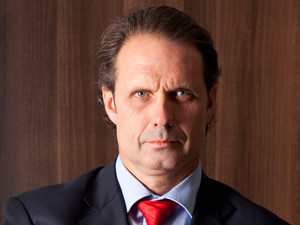
Beneath the madding buzz around scandals at major banks, developed countries' financial trading technologies are quietly revolutionising the way we send money around the world. A growing deluge of ever-faster, lower-margin transactions exploit new revenue streams. For certain smaller transactions, humans may have no part to play at all. In the faster, more connected global financial network, a technical glitch in one stock exchange can hold up billions within minutes.
The high-speed revolution sees lawmakers scrambling to protect markets from exchange crashes, and developing-country traders fearing invasions from foreign market forces using advanced tools.
Computerised trading is now the norm. New trading patterns have evolved globally through the advent of algorithmic trading and Direct Market Access (DMA), where human traders are outperformed by artificial ones, says Heinrich Degener, a senior executive at Accenture South Africa, heading up technology for financial services.
"High Frequency Trading (HFT) is on the rise. Ultra-low latency requirements drive co-location in the direct vicinity of the actual exchange or trading engine, to cut out valuable nanoseconds of transmission time. Algorithms are becoming more and more sophisticated, and no longer just go for volume weighted average price (VWAP) execution," he says.
"While retail banks are still getting their analytics going, capital markets have already embraced the real-time processing of enormous amounts of data through Complex Event Processing (CEP), to feed the order execution algorithms directly. Exchanges globally are upgrading their systems to deal with the trend of largely increased transaction numbers - some of them able to process up to a million orders per second."

In addition, two industry developments in particular offer lower cost transactions to traders: DMA and the burgeoning international Financial Information eXchange (FIX) protocol.
Standardisation
Continues Degener: "DMA itself is changing not only the way trades are executed, but has also forced the selling side to revamp their business models. One important aspect of DMA is still missing in South Africa, though: the market aggregation component, as the local market is largely dependent on a single trading venue.
"DMA offers benefits for users such as low-cost execution and savings on IT infrastructure. DMA providers can benefit from retaining order flows and amortising high IT costs."
Limiting trading scandals
Reconstructing audit trails Trading and broking scandals can blow up over typical weaknesses in organisations. Maybe staff accessed systems they should not have, due to bad separation of duties. Password management and user authentication may not be up to scratch. Head office may sport top-class risk management and security systems. Meanwhile, traders often breach rules not at head office but at branches in other countries, for example, says Gontse Tsatsi, financial services industry consultant at Gijima. "You're essentially allowing a guy to do the same job off-site, but not ensuring that it's equally secure," he adds. So far, so run-of-the-mill. But billion-dollar bank frauds require something more, says Tsatsi, like having to break through perimeter security, to then freely access data, most of which is unencrypted. In one of the big financial services technology shifts, banks are starting to add data encryption, he says, and in another, starting to use fraud prevention and anti-money laundering (AML) tools. "These tools monitor what you do as well as your behaviour," says Tsatsi. "The system knows that if the market performs in a certain way, trader Y normally trades this much, and these are the sort of trades that he does." But it's not enough to monitor behaviour and identify unusual trades for a person. On top of sending alerts, the system must also be able to enforce rules that automatically stop any further transactions, he adds. Yet a third shift in trading technology use has to do with nabbing rogues and managing scandal. "Increasingly, software is loaded on trading workstations to record every keystroke. Once a trader has done something he shouldn't have, the auditing part becomes easy to do." Without a robust auditing trail, a court case against a trader will run into severe difficulties. Worse, US and European legislation already requires banks and other organisations to report breaches of personal information to the people targeted, and SA is going the same way. Clause 21 of the pending Protection of Personal Information (POPI) Bill requires the breached organisation to notify the future Information Regulator and affected individuals. Further, the already red-faced company will have to prominently display a notification of the breach on its Web site and publish it in the news media, as required by the regulator. And then POPI has another sting in its tail. "Once the Bill is enacted, organisations are forced to report and show corrective measures. If you don't show corrective measures, there could be penalties hurting your bottom line and your reputation. Companies will definitely spend on getting the required security tools." In SA, tier-one banks are on the ball, having implemented leading fraud prevention and AML solution Nice Actimize in their trading departments already, Tsatsi says. Another AML solution available locally is Intellinx. Gijima itself provides monitoring solution ObserveIT. Staying one step ahead of trading temptations is not just a technology thing, Tsatsi says. Policy, procedures and rules have to be strong and constantly revised whether the company is getting hit or not.
The second industry development, the FIX protocol, enables software developers to create commercial or open-source software for electronic trading. According to its Web site, the communications protocol 'has been developed through the collaboration of banks, broker-dealers, exchanges, industry utilities and associations, institutional investors, and information technology providers from around the world'.
"The FIX protocol, as the industry-driven messaging standard, has definitely helped to drive standardisation around this," says Degener.
"South Africa as a market is lagging international developments, with the local exchange only having embraced the FIX protocol in 2009, years after European exchanges started to provide its wrapper for their proprietary interfaces.
"However, the catchup is running at an enormous pace. FIX allows market players to easily and cost-efficiently utilise market-driven solutions, lowering entry barriers and reducing connectivity cost into the 'game'. It will also continue to attract global players into the local market, further enhancing the depth and liquidity of the market for the benefit of the entire ecosystem."
Like trading and broking, core banking systems are mostly invisible to the media.
Apart from several external factors driving local banks towards re-engineering themselves, the institutions experience key internal change drivers as well, says Paul Wilde, financial services sales director at Software AG.
"Banks are looking to better utilise their IT infrastructure, modernise what they have, and kick out so-called legacy environments."
The goal is better cost-effectiveness.
"A key reason banks are not keen to change is finding a platform to replace a 25-year-old bespoke platform they developed themselves to perfectly suit their requirements. The replacement has to offer the same level of functionality at less cost, which is near impossible to do," adds Wilde.
"It is also extremely difficult to migrate all the required data elements to a new platform. Migrating a large system can take two or three years.
"A lot of institutions locally and globally are looking at re-using the environment, so the mainframe remains relevant. Companies are looking at Service Orientated Architecture (SOA), looking at creating a services platform. However, they re-engineer the GUI front-end and modernise it."
Portal technology
Two technologies in particular are relevant in financial services now, says Greg Vercellotti, MD at Dariel Solutions.
Insuring client data
Providing continuity when a short-term broker goes belly-up. Short-term insurers everywhere face a giant wave of new laws with which they need to comply, says Christine Sheffield, CIO at Innovation Group. The Insurance Laws Amendment Act (ILAA) is partly responsible for an industry-wide initiative, the Short Term Insurance Data Exchange called (STRIDE), started in 2009, says Sheffield. Thousands of short-term insurance brokers ply their business in the country, gathering lots of information about their customers in the process. However, if a broker goes out of business, the insurer needs to have all that client information to ensure continuity of service. But some brokers don't share all client information with insurers. Meanwhile, legislative requirements in the ILAA require insurers to have access to their client and policy data. STRIDE will provide a secure method for transferring client data between the insurers and intermediaries, says Sheffield. "This data is held in many different formats and on many different systems throughout SA, but it needs to be received in a standardised format. STRIDE is asking for data to conform to a South African version of the international ACORD data standard, and to be sent to a data switch. "STRIDE is now encouraging brokers to send their data to the insurance companies in that format, which makes things interesting for solution providers like us: we enable them to send data back to the insurance companies via the switch. "The switch is up and running. We are running a pilot with one of the big insurance companies, and one of their brokers. We're starting to do the data mapping to ensure the broker can send the information in the required format."
One is the mobile platform added to client interactions. Typically, an institution will target small pieces of high-value functionality, delivered very quickly and reliably to clients on mobile phones. In retail banking, getting in balances and transfers on mobile phones is a good example.
The other technology is outward-facing portal technology to custom communities, such as intermediaries and brokers - outside people who need access to information inside the institution, says Vercellotti.
"Such a portal brings together transactional data from many systems. We are seeing some big portal projects about to be delivered in some of the big financial services companies," he adds.
"On these projects, a company may say, 'We want to deliver a seamless transaction', but that transaction means talking to the CRM system in the back-end, the lead generation system, the transactional system, the payment system. We need to get information from, and put information into, all those systems.
"But you can't give your brokers access to all these systems. If they don't have access, they have to phone in to get the information. If you go through the Web, you have to write all those interfaces and deliver it through a Web page.
"With portal technology, you take it to the next level. The architecture allows you to pull together all the bits and pieces of a transaction and deliver them to the end-user in one transaction. This is a form of SOA, because you are abstracting out the business transaction."
When SOA is combined with portal technology, a bank can decouple business processes from the original (legacy) data sources. Once enough legacy sources have been decoupled, it becomes possible to start a slow migration to newer technology, says Vercellotti.
Away from the public eye, financial services companies are employing new technologies and approaches. These support the financial wellbeing of everyone dependent on the industry's products and services.
First published in the September 2012 issue of ITWeb Brainstorm magazine.
Share